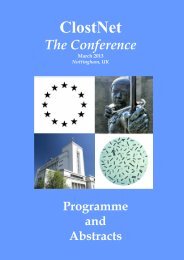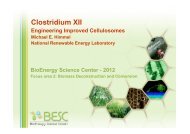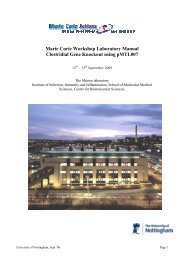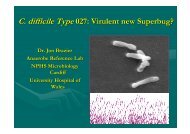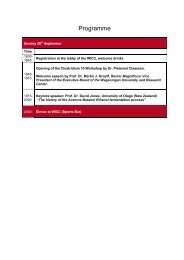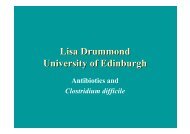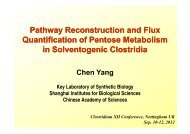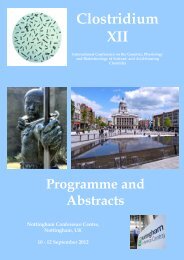abstract book - Clostridia
abstract book - Clostridia
abstract book - Clostridia
- No tags were found...
You also want an ePaper? Increase the reach of your titles
YUMPU automatically turns print PDFs into web optimized ePapers that Google loves.
STRUCTURE-FUNCTION ANALYSIS OF THE HOLIN-LIKE TCDE FROMCLOSTRIDIUM DIFFICILEA. Olling, S. Seehase, H. Tatge, I. Just, R. GerhardInstitute of Toxicology, Hannover Medical School, Hannover (Germany)The pathogenicity locus of C. difficile exhibits an ORF (tcdE) locatedbetween the tcdA and tcdB genes encoding the 19 kDa protein TcdE. TcdEshows significant sequence homology to bacteriophage-encoded holinswhich are lytic proteins causing cell death of bacterial host cells. This findingled to the hypothesis that TcdE participate in the delivery of toxins A and Bto the extracellular environment of C. difficile. Since expression of TcdE in E.coli leads to bacterial cell lysis, we used this property to study the influenceof expressed (full length and deleted) TcdE on the growth profile of E. coli.Additionally, site-directed mutagenesis was performed to investigate aputative dual start motif which might account for TcdE protein of differentlength and function, as it is known for holins. The expression of deletionmutants lacking either the N- or C- terminus or both in E. coli resulted ininhibition of bacterial growth whereas a fusion construct of only the N- andC- termini (lacking the intermediate part) had no effect. For specific detectionin Western blot analysis a polyclonal anti-TcdE antibody was generated. Theexpression pattern of wild type TcdE reflects a 19 kDa and a 16 kDa protein.Mutagenesis analysis confirmed a dual start motif enabling the expression ofproteins with different length and function. The mutation within the ribosomebinding site shifted the ratio of full length to truncated protein from 1:10 to1:1. After induction of TcdE expression, recovery of the optical density wasobserved. This reversal in growth inhibition was due to base insertions intotcdE DNA which can be construed as a bacterial regulation against TcdEinducedtoxicity. The altered expression pattern of the mutant TcdE wasaccompanied by a delayed recovery of bacterial growth reflecting a strongerselection force exerted by the 16 kDa protein, and thus revealing a morepotent impact of the truncated TcdE. This conclusion is corroborated by theobservation that a mutant construct expressing the full length TcdEexclusively, mediates a bacteriostatic but not a lytic effect.These data indicate an essential role of the hydrophobic transmembranedomains of TcdE in inhibition of bacterial growth. The dual start motifregulates the ratio of full length (19 kDa) to truncated (16 kDa) TcdE.Truncated TcdE is proposed to be the active bacteriolytic protein whereasfull length TcdE probably acts as its antagonist.



